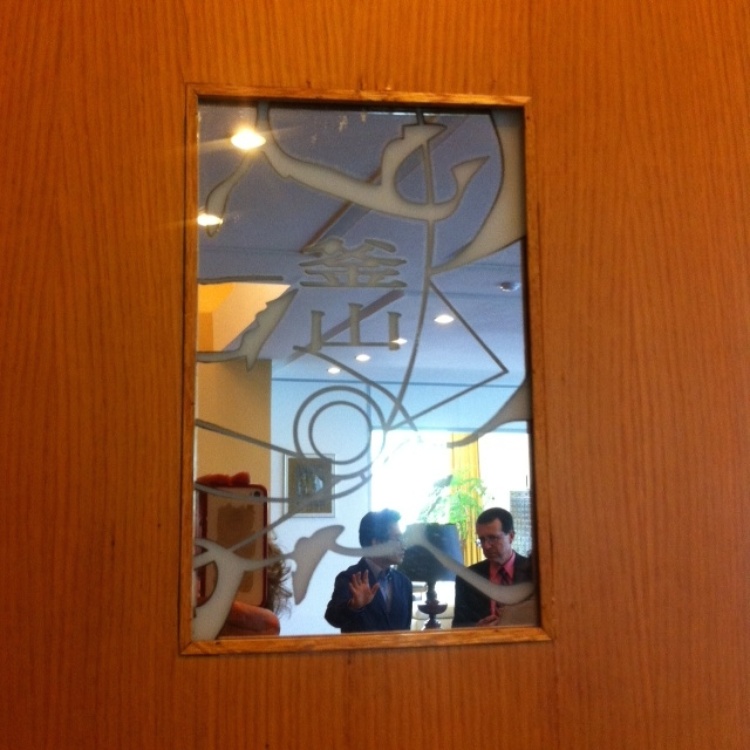
Today the French Ambassador to Korea, Jerome Pasquier has generously organized a lunch to introduce me to local artists and intellectuals. What a treat! All the more since the French residence immediately appears to me as an absolutely gem of architecture. At first, it seems to hide itself on the top of a hill, behind an oriental garden as if to be deserved. But, as soon as I step inside, I feel as if I were attending an elegant chamber music concert, with European modernist lines and traditional Korean objects interpenetrating each other, enhancing each other. How magnificent, this Korean antique piece of pharmacy furniture facing the portrait of the previous owner, in his traditional attire! Later on, I will understand from the ambassador the reasons of my coup de foudre for this place. Built in 1962 by Kim Jung-up (the leading Korean architect who worked with Le Corbusier), it is considered as one of the masterpieces of Korean architecture. I’ll also learn that it is topographically set between two hills (Inwha-san to the West and Nam-san to the South) and that the architect designed it very carefully, in respecting the most ancient local geomancy traditions, in which nature and forms try to coincide. Thus, over the years, the French residence has acquired the reputation of keeping and redistributing the energy of Seoul, thanks to its monumental Pagoda-shaped roof which Kim Jung-up, in a very interesting intercultural metaphor, described as turning into “a flying carpet” at night. I just found an excellent text about the diplomatic function of French residences abroad, and especially the Seoul one.
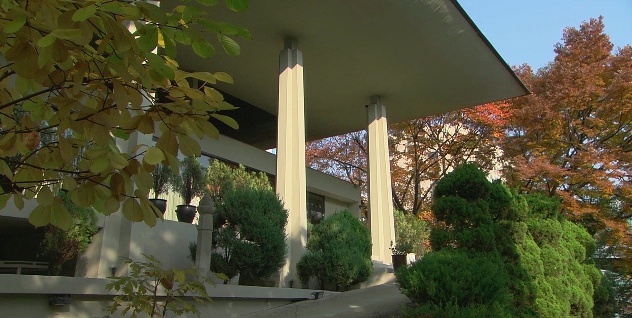

While I’m looking all around, it is somewhat challenging to start focusing on the conversation with such a rich and interesting group of people (on the picture, from left to right: Soo-Bok CHEONG, Daniel Ollivier, Jacques Soullilou, Hyerie HAHM, Benjamin Joinau, Miran CHANG, Jerome Pasquier, Kyung-ah HAM, Soocheon JHEON, Yeon-Du JUNG, ACS, Laetitia Favro. The conversation launched by the ambassador throughout the table focuses on the function of art in Korean society (should it be political or poetical?) and it seems that the tensions between North and South are still awfully present in all minds, even if also, to a lesser degree, people keep describing the scars after the Japanese occupation, and the wounds from the unbalanced relationship with gigantic China, with the words “double bind”, “otherness”, “subversion” being pronounced on and on. With Jheon Soocheon sitting to my right, I discuss my interpretation of Rothko as a migrant and a pioneer and we recall the great figures of Nam June Paik and Lee Ufan, who also experienced geographic migrations. Jheon Soocheon tells me about the White Line that he has designed between Berlin and Seoul, and about his future project in Paris with an interactive train. There is really magic about being able to access so much with so many people in such a short time: the guests are friendly, well-travelled, demanding, mobile, and I immediately know they’ll become friends. Energized by this input of Korean creativity, I lean toward Soo-Bok, to my right: “Too bad that everything has been cancelled about my book!”, I say. I see him stand up, leave the room and, a few seconds later, come back, with a big smile: “Just after lunch, you’ll come with me for an interview with Dong-a! It’s a daily paper will sells a million 200.000 copies, more than Le Figaro, Le Monde and Libération all together!”
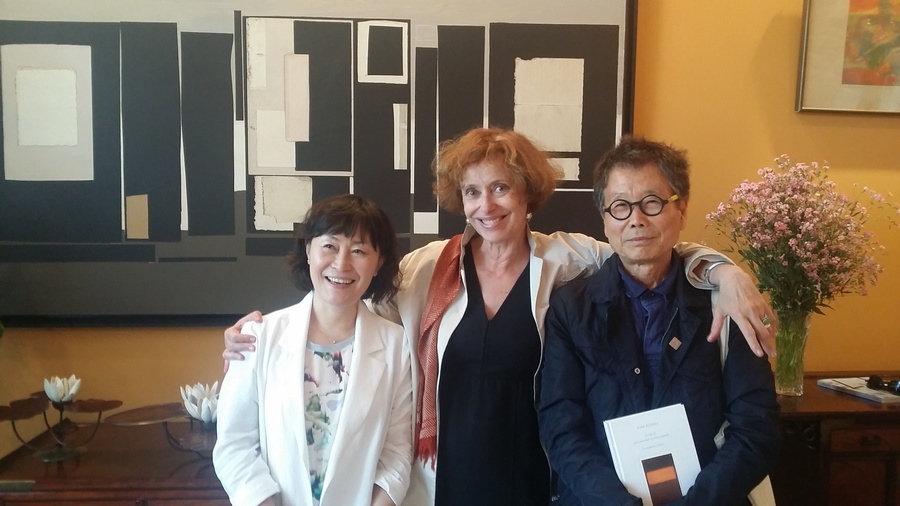
The rest of the day will follow up according to this incredible pace: Hwasun, the journalist who leads the interview is brilliant, very well-read and fun, she wants to know what happened and she will become a friend. She tells me that I should go see the play Red (it had been a hit on Broadway some years ago) which is now been presented in the city. Thanks to the French Institute once more, we manage to get tickets for the same evening, and we crisscross the city, travelling to Corso Como in Gangnam -a brand new and elegant immense neighorhood, born within a few years in what used to be rice-lands. It is on the other side of the river Han and I love travelling back by subway -such a friendly, clean and efficient subway! Walking toward the play in Chungmu art hall, we find ourselves in the center of the city, a neighborhood which mingles traditional shopkeepers selling all kinds of vegetable and fish with theaters and cultural institutions… It’s so beautiful, so colorful, so intense…This is a day of riches.
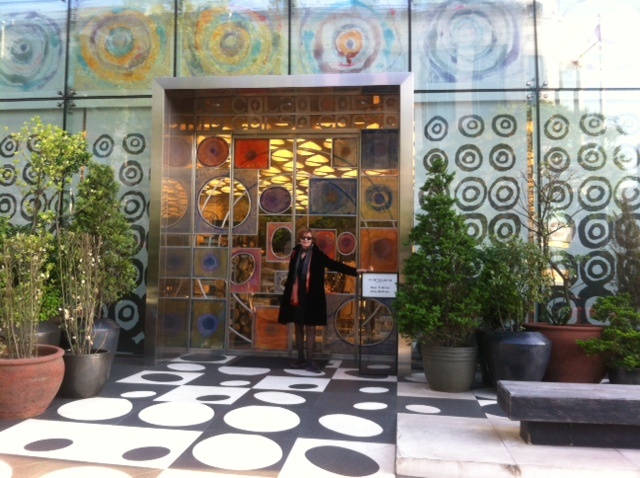

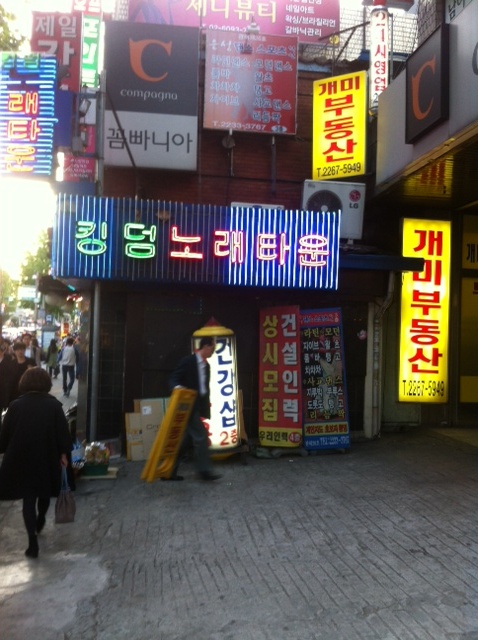
The play Red, by John Logan, presents Rothko in 1959, exchanging in his studio with his assistant Ken, and agonizing about the Seagram panels that he had been commissioned to decorate the Four Seasons restaurant, on Park Avenue. It relates the moment when the artist decides to break away from the commercial grip on his art and turn to something more intellectual and philosophical. I’ve read the short text, but I’ve not seen the play and it is funny to follow it in Korean language. Tonight, Mark Rothko is being played by JUNG Bo-Seog whom I find excellent: with his glasses, with his heavy walk, with his glass of vodka in hand, what a marvelous challenge to be presenting a Russian intellectual in New York city, during the late fifties to a Korean audience! With Miran and Soo-Bok, we spend half an hour discussing with him backstage. Miran tells me that he’s a star, “the James Dean of its time”, and a very well regarded actor. In the conversation, I find him extremely concerned by Rothko as an artist; he is nice, sensitive, and incredibly committed. “It is the most difficult role I ever had to play in my professional life of 30 years”, he asserts. “Every day, I try to approach the role more closely, please tell me, do you think I succeded?” Strangely, it seems to me that Bo-Seog is serving Rothko much more genuinely than the show at the Hangaram Center…In the lobby of the theater, we meet with a young nurse who’s having her picture taken in front of the poster I ask her why. She says that she’s has been travelling three times to see the play, because she became totally fascinated by Rothko.
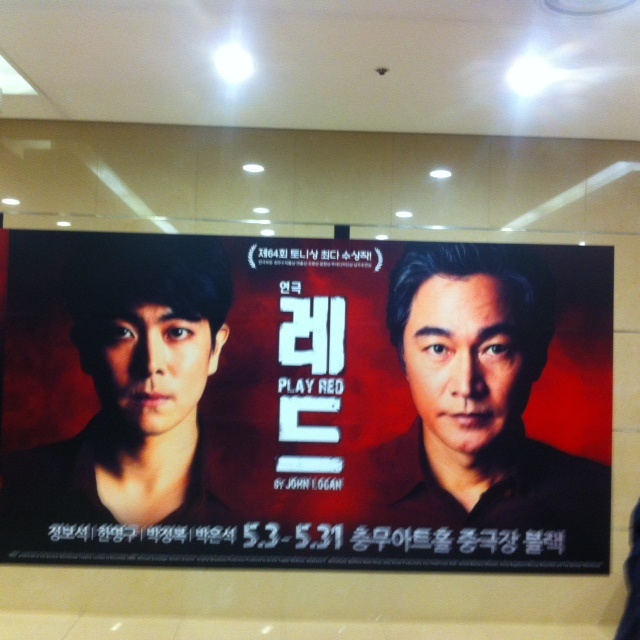

Before going to bed, I decide to write Anne Bihan, at Yale UP in London -she’s a marvelous friend, a very efficient professional and she was so happy when she sold Mark Rothko’s rights to Korea. Mechanically and desperately, I write : « Dear Anne, Why has my publisher disappeared ? Why has he not contacted us at all recently ? Where is he? Where’s the book ? Will l I have a chance to meet him before I leave the country ? Best, Annie»
par Annie Cohen-Solal



